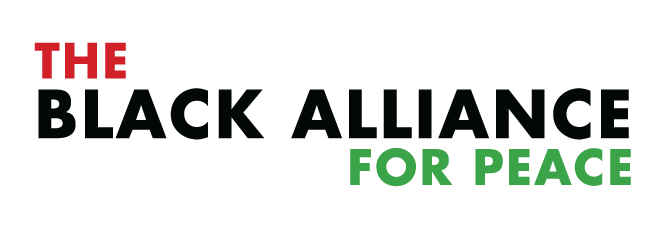DECLARATION: Building a People(s)-Centered Zone of Peace in the Americas
In Havana, Cuba, on January 29, 2014, the heads of state and governments of the Community of Latin American and Caribbean States (CELAC) declared Latin America and the Caribbean should be seen and respected as a “Zone of Peace.”
This declaration from government representatives, however, has not translated into a people(s)-centered movement across the region. The Black Alliance for Peace (BAP) believes that it is only through the concentrated efforts of the people that the Americas will free itself of the anti-human, anti-democratic and violent policies that Western imperialist subversion and militarism have brought to the peoples and nations in our region.
Lifting up as a popular demand that our region be free of externally-imposed state violence is even more important today as it was when the declaration was issued in 2014. From the assault on democracy in Haiti to the subversion and illegal sanctions directed at Cuba, Venezuela and Nicaragua, the nations in Latin America and the Caribbean continue to find themselves in an existential battle against geo-strategic interests of the hegemon to the North—the United States of America.
Ending the Militarization of the Americas
Dictated by Monroe Doctrine directives and attempts to expand Western hegemony, the West uses both hard- and soft-power mechanisms in the Americas. These structures are forged through global capitalism, militarism and police violence, as well as the through multinational machinations of organizations that serve as proxies for U.S./Western economic and political power.
Police and military training, arms sales, and increasingly intrusive activities of the U.S Southern Command (SOUTHCOM) structure in our region represent the military components of U.S. policies. And with the reformulated U.S. national security strategy that was articulated in 2018, which identified Russia and China as existential threats to the United States, militarization has developed with the emphasis on “great power competition,” moving Our Americas back into the center of international intrigue.
Building up the Zone of Peace means prioritizing People(s)-Centered Human Rights (PCHRs) in the Americas by observing the principles of national sovereignty, equal rights and self-determination of peoples. This requires ending the foreign military presence and bases, as well as all structures and practices of regional militarization.
Other aspects of the Zone of Peace include exposing the lie of benevolent and democracy-driven “humanitarianism” that fuels the soft-power imperialist projects of the United States and NATO, as well as the Core Group, the United Nations, United States Agency for International Development (USAID) and the Organization of American States (OAS). Democracy and “human rights'' as dictated by the West must be understood as no more than ideological props.
Activating the Popular Movement Element of the Zone of Peace
The response to this militarism as well as to occupying forces must be built from the bottom-up through popular struggle, rather than relying on governments to act. Therefore, BAP, along with key partner organizations, is calling on the peoples and nations of the Caribbean and Latin America to build, grow and defend the Zone of Peace of the Americas.
BAP is building a region-wide coalition to rid the Americas of warmongers and foster a network of popular-peoples’ struggles. Grounded and informed by the needs and aspirations of the oppressed, this network would anchor a unified comprehensive strategy for decolonization and radical social change.
As part of this work, we in the United States, and all of North America, must cease to see ourselves as fundamentally different from people in “Latin America and the Caribbean.” We, the oppressed and colonized living within the heart of empire, see it as our duty to confront the empire from within. We ask all colonized people to join in the struggle to end imperialist domination and to build collective self-determination in Our Americas.
We aim to build awareness about the idea of a “Zone of Peace” across the Americas. This means, first and foremost, opposing the stronghold of the interlocking issues of global conflict, nuclear armament and proliferation, unjust war, as well as subversion. This is only possible through the defeat of Western-led global systems of oppression that include colonialism, imperialism, patriarchy and white supremacy.
The Work of Peace
Building out a people-to-people network for a “Zone of Peace” in the Americas would involve developing public education, advocacy, grassroots organizing and social-media campaigns. These activities would build awareness on the idea of a “Zone of Peace” across the Americas, as well as create avenues for communication to connect organizations and individuals in areas where imperialist violence is most intense.
Heightening the contradictions of the “rules-based international order” through region-wide, non-state campaigns, would build capacity for a more effective strategic engagement.
Coordinating among anti-imperialist organizations, political parties, labor and social-justice organizations, as well as movements across our region, we will move the region toward building alternative institutions and centers of power.
This work must be de-colonial, anti-imperialist, advance a People(s)-Centered Human Rights (PCHRs) framework, and be conducted across at least five languages: English, Spanish, Portuguese, French and Haitian Creole.
We declare Our Americas to be a Zone of Peace. And we resolve to organize, engage and fight for our right to peace.
Join the call to build a Zone of Peace in Our Americas! We invite organizations and individuals to endorse the Zone of Peace campaign and activate the popular movement element in this multi-phase campaign that aims to build a united-front opposition to liberate our Americas from the U.S./EU/NATO Axis of Domination. Endorse here.
Banner photo: Haitian male youth standing proudly in front of a mural by Bungy Baka, that says “MOLEGHAF, Black Alliance for Peace”; courtesy unknown photographer.

